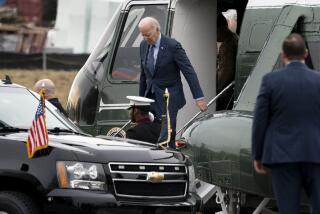State Seeks Health Files of Rockwell Employees : Investigation: Officials say they will gather records for a study to determine whether workers have an unusual rate of bladder cancer or other disease.
- Share via
Under pressure from lawmakers, state health officials Friday promised to get the health records of workers at the Santa Susana Field Laboratory and two other Rockwell International plants as the first step in investigating whether company workers have experienced unusual rates of disease.
At a legislative hearing in Chatsworth, Dr. Lynn Goldman, the state chief of environmental epidemiology, assured legislators that she would take legal action if necessary to secure the records.
Rockwell spokesmen at the hearing said they expect to voluntarily comply.
That left open the question of where the state’s understaffed and financially strapped epidemiology branch will find the money to study the health of workers at Rockwell’s Santa Susana site in eastern Ventura County and its Canoga Avenue and De Soto Avenue plants in Canoga Park.
Assemblyman Richard Katz (D-Sylmar), one of three lawmakers who held the hearing, said after the session that he will work to solve the funding problem once the records are in hand.
The four-hour hearing ended a turbulent week for Rockwell facilities.
Health officials earlier had disclosed “extremely preliminary” data showing a small increase in bladder cancer rates in three Canoga Park and Chatsworth census tracts east of the Santa Susana lab, where Rockwell used to do nuclear research and still tests rocket engines for the government.
The statistical report contained no information about the work, residence or smoking history of bladder cancer patients and drew no conclusions about the cause of the apparent increase.
Katz was joined at Friday’s hearing by Assemblyman Terry B. Friedman (D-Los Angeles) and Assemblywoman Cathie Wright (R-Simi Valley).
The gathering served as a stage for lawmakers to pummel health officials for waiting until a few days ago to release the cancer data, which had been on hand since fall.
The hearing also became a negotiating session. The legislators pressured the state health officials, Rockwell and the U.S. Department of Energy to clear away obstacles to further studies.
The DOE is involved because Rockwell formerly did nuclear work and still does energy research at Santa Susana for the agency.
Anti-nuclear and community activists, joined by the lawmakers, contend that the best way to determine if Rockwell operations posed a health threat would be to study company workers.
They presumably were more exposed to any danger than people living in the neighborhood.
But the Energy Department has farmed out worker studies to the U.S. Department of Health and Human Services, which is unlikely to include Santa Susana in studies of several larger DOE weapons and research sites.
The Energy Department plans to provide the state Department of Health Services up to $341,000, but only for an exposure assessment--a study to determine if past toxic or radioactive releases at Santa Susana could conceivably have caused health problems.
Rockwell officials say there has never been a significant off-site release of contaminants.
“The Department of Energy does not want to buy a worker epidemiology study for us,” Goldman told the lawmakers.
At Katz’s urging, Goldman agreed to get the worker data from Rockwell, by going to court if necessary.
Steve Lafflam, director of environmental control for Rockwell’s Rocketdyne Division, said the company is “here to cooperate and make available any records that are legally releasable.”
Katz led off the hearing by criticizing the state health department for delaying release of the bladder cancer report. “What did the Department of Health Services know, when did they know it and why it was kept secret for five months?” he said.
In response, Goldman cited her “extremely limited” budget for investigating hazardous sites throughout the state, explaining that work done so far on Santa Susana has been “on our own nickel and at the expense of other sites.”
She said the bladder cancer report was forwarded to her staff for review in October.
After that review, and to save the time of preparing a special meeting, it was decided to discuss the data at the next meeting of the task force of government agencies overseeing cleanup at Santa Susana, which took place on Monday.
She said the report was provided to Rockwell in January in advance of the meeting and on the same day placed in public libraries that keep reports on Santa Susana.
“We really should have delivered it to your office,” she said to Katz. To the audience she said, “It’s our desire to be open with you . . . and to involve the public as much as possible.”
Testifying near the end of the meeting, Barbara Johnson, a Rockwell critic who lives near the field laboratory and has been a vocal advocate of health studies, revealed that she was diagnosed as having breast cancer a year ago and has been treated for the illness.
Johnson, who said she has lived for the last 20 years about two miles from Santa Susana, explained later that she had not intended to disclose her illness and “was not accusing Rockwell.”
She decided to make the disclosure because of the bladder cancer scare. “I really felt it was a way to express the fears the community is feeling,” Johnson said.
More to Read
Sign up for Essential California
The most important California stories and recommendations in your inbox every morning.
You may occasionally receive promotional content from the Los Angeles Times.










